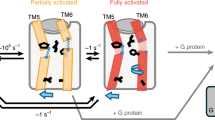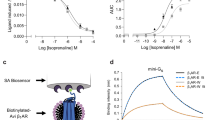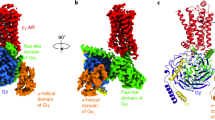Abstract
Stimulation of β2-adrenergic receptors on the cell surface by adrenaline or noradrenaline leads to alterations in the metabolism, excitability, differentiation and growth of many cell types. These effects have traditionally been thought to be mediated exclusively by receptor activation of intracellular G proteins1. However, certain physiological effects of β2-adrenergic receptor stimulation, notably the regulation of cellular pH by modulation of Na+/H+ exchanger (NHE) function, do not seem to be entirely dependent on G-protein activation2,3,4,5,6,7. We report here a direct agonist-promoted association of the β2-adrenergic receptor with the Na+/H+ exchanger regulatory factor (NHERF), a protein that regulates the activity of the Na+/H+ exchanger type 3 (NHE3)8. NHERF binds to the β2-adrenergic receptor by means of a PDZ-domain-mediated interaction with the last few residues of the carboxy-terminal cytoplasmic domain of the receptor. Mutation ofthe final residue of the β2-adrenergic receptor from leucine toalanine abolishes the receptor's interaction with NHERF andalso markedly alters β2-adrenergic receptor regulation of NHE3 in cells without altering receptor-mediated activation of adenylyl cyclase. Our findings indicate that agonist-dependent β2-adrenergic receptor binding of NHERF plays a role in β2-adrenergic receptor-mediated regulation of Na+/H+ exchange.
This is a preview of subscription content, access via your institution
Access options
Subscribe to this journal
Receive 51 print issues and online access
$199.00 per year
only $3.90 per issue
Buy this article
- Purchase on SpringerLink
- Instant access to full article PDF
Prices may be subject to local taxes which are calculated during checkout





Similar content being viewed by others
References
Dohlman, H. G., Thorner, J., Caron, M. G. & Lefkowitz, R. J. Model systems for the study of seven-transmembrane-segment receptors. Annu. Rev. Biochem. 60, 653–688 (1991).
Barber, D. L., McGuire, M. E. & Ganz, M. B. β-Adrenergic and somatostatin receptors regulate Na–H exchange independent of cAMP. J. Biol. Chem. 264, 21038–21042 (1989).
Ganz, M. B., Pachter, J. A. & Barber, D. L. Multiple receptors coupled to adenylate cyclase regulate Na–H exchange independent of cAMP. J. Biol. Chem. 265, 8989–8992 (1990).
Barber, D. L. & Ganz, M. B. Guanine nucleotides regulate β-adrenergic activation of Na–H exchange independently of receptor coupling to Gs. J. Biol. Chem. 267, 20607–20612 (1992).
Barber, D. L., Ganz, M. B., Bongiorno, P. B. & Strader, C. D. Mutant constructs of the β-adrenergic receptor that are uncoupled from adenylyl cyclase retain functional activation of Na–H exchange. Mol. Pharmacol. 41, 1056–1060 (1992).
Bellow-Reuss, E. Effect of catecholamines on fluid reabsorption by the isolated proximal convoluted tubule. Am. J. Physiol. 238, F347–F352 (1980).
Weinmann, E. J., Sansom, S. C., Knight, T. F. & Senekjian, H. O. Alpha and beta adrenergic agonists stimulate water absorption in the rat proximal tubule. J. Membrane Biol. 69, 107–111 (1982).
Weinman, E. J., Steplock, D., Wang, Y. & Shenolikar, S. Characterization of a protein cofactor that mediates protein kinase A regulation of the renal brush border membrane Na+–H+ exchanger. J. Clin. Invest. 95, 2143–2149 (1995).
Reczek, D., Berryman, M. & Bretscher, A. Identification of EBP50: a PDZ-containing phosphoprotein that associates with members of the ezrin-radixin-moesin family. J. Cell Biol. 139, 169–179 (1997).
Weinman, E. J., Steplock, D. & Shenolikar, S. cAMP-mediated inhibition of the renal brush border membrane Na+–H+ exchanger requires a dissociable protein cofactor. J. Clin. Invest. 92, 1781–1786 (1993).
Sheng, M. PDZs and receptor/channel clustering: rounding up the latest suspects. Neuron 17, 575–578 (1996).
Kornau, H. C., Schenker, L. T., Kennedy, M. B. & Seeburg, P. H. Domain interaction between NMDA receptor subunits and the postsynaptic density protein PSD-95. Science 269, 1737–1740 (1995).
Songyang, Z.et al. Recognition of unique carboxyl-terminal motifs by distinct PDZ domains. Science 275, 73–77 (1997).
Yun, C. H. C.et al. cAMP-mediated inhibition of the epithelial brush border Na+/H+ exchanger, NHE3, requires an associated regulatory protein. Proc. Natl Acad. Sci. USA 94, 3010–3015 (1997).
Cabado, A. G.et al. Distinct structural domains confer cAMP sensitivity and ATP dependence to the Na+/H+ exchanger NHE3 isoform. J. Biol. Chem. 271, 3590–3599 (1996).
Kurashima, K.et al. Identification of sites required for down-regulation of Na+/H+ exchanger NHE3 activity by cAMP-dependent protein kinase. Phosphorylation-dependent and -independent mechanisms. J. Biol. Chem. 272, 28672–28675 (1997).
Weinman, E. J. & Shenolikar, S. Regulation of the renal brush border membrane Na+/H+ exchanger. Annu. Rev. Physiol. 55, 289–304 (1993).
Noel, J. & Pouyssegur, J. Hormonal regulation, pharmacology, and membrane sorting of vertebrate Na+/H+ exchanger isoforms. Am. J. Physiol. 268, C283–C296 (1995).
Orlowski, J. & Grinstein, S. Na+/H+ exchangers of mammalian cells. J. Biol. Chem. 272, 22373–22376 (1997).
Kahn, A. M., Dolson, G. M., Hise, M. K., Bennett, S. C. & Weinman, E. J. Parathyroid hormone and dibutyryl cAMP inhibit Na+/H+ exchange in renal brush border vesicles. Am. J. Physiol. 248, F212–F218 (1985).
Dolson, G. M., Hise, M. K. & Weinman, E. J. Relationship among parathyroid hormone, cAMP and calcium in proximal tubule sodium transport. Am. J. Physiol. 249, F409–F416 (1985).
Weinman, E. J., Shenolikar, S. & Kahn, A. M. cAMP-associated inhibition of Na+–H+ exchanger in rabbit kidney brush-border membranes. Am. J. Physiol. 252, F19–F25 (1987).
Agus, Z. S., Puschett, J. B., Senesky, D. & Goldberg, M. Mode of action of parathyroid hormone and cyclic adenosine 3′–5′ monophosphate on renal-tubular phosphate reabsorption in the dog. J. Clin. Invest. 50, 617–626 (1971).
Ferguson, S. S. G., Barak, L. S., Zhang, J. & Caron, M. G. G-protein-coupled receptor regulation: role of G-protein-coupled receptor kinases and arrestins. Can. J. Physiol. Pharmacol. 74, 1095–1110 (1996).
Strader, C. D.et al. The carboxyl terminus of the hamster β-adrenergic receptor expressed in mouse L cells is not required for receptor sequestration. Cell 49, 855–863 (1987).
Bouvier, M.et al. Removal of phosphorylation sites from the β2-adrenergic receptor delays the onset of agonist-promoted desensitization. Nature 333, 370–373 (1988).
Cheung, A. H., Sigal, I. S., Dixon, R. A. F. & Strader, C. D. Agonist-promoted sequestration of the β2-adrenergic receptor requires regions involved in functional coupling to Gs. Mol. Pharmacol. 35, 132–138 (1989).
Opperman, M.et al. Monoclonal antibodies reveal receptor specificity among G protein-coupled receptor kinases. Proc. Natl Acad. Sci. USA 93, 7649–7654 (1996).
Barak, L. S., Ferguson, S. S. G., Zhang, J. & Caron, M. G. Aβ-arrestin/green fluorescent protein biosensor for detecting G protein-coupled receptor activation. J. Biol. Chem. 272, 27497–27500 (1997).
Samama, P., Cotecchia, S., Costa, T. & Lefkowitz, R. J. Amutation-induced activated state of the β2-adrenergic receptor: extending the ternary complex model. J. Biol. Chem. 268, 4625–4636 (1993).
Acknowledgements
We thank J. Shannon for peptide sequencing; T. Kurose for the β2 receptor tail GST fusion protein construct; N. Freedman for the Flag-tagged wild-type β2 receptor construct; J. Raymond for advice; G. Irons, D.Steplock and K. Tate for technical assistance; and D. Addison and M. Holben for help in preparing the manuscript. This work was supported in part by grants from the NIH to R.J.L. and E.J.W. and from theDuke Comprehensive Cancer Center to S.S.; C.W.C. is the recipient of a clinician–scientist award fromthe Department of Medicine at the University of Toronto; A.C. is a recipient of a postdoctoral fellowship from the Heart and Stroke Foundation of Canada; and S.G. is an international scholar of the Howard Hughes Medical Institute.
Author information
Authors and Affiliations
Corresponding author
Rights and permissions
About this article
Cite this article
Hall, R., Premont, R., Chow, CW. et al. The β2-adrenergic receptor interacts with the Na+/H+-exchanger regulatory factor to control Na+/H+ exchange. Nature 392, 626–630 (1998). https://doi.org/10.1038/33458
Received:
Accepted:
Issue Date:
DOI: https://doi.org/10.1038/33458
This article is cited by
-
Function and dynamics of the intrinsically disordered carboxyl terminus of β2 adrenergic receptor
Nature Communications (2023)
-
Scribble co-operatively binds multiple α1D-adrenergic receptor C-terminal PDZ ligands
Scientific Reports (2019)
-
A molecular code for endosomal recycling of phosphorylated cargos by the SNX27–retromer complex
Nature Structural & Molecular Biology (2016)
-
Individual protomers of a G protein-coupled receptor dimer integrate distinct functional modules
Cell Discovery (2015)
-
Regulation of β2-adrenergic receptor cell surface expression by interaction with cystic fibrosis transmembrane conductance regulator-associated ligand (CAL)
Amino Acids (2015)



